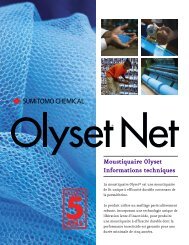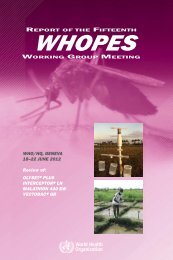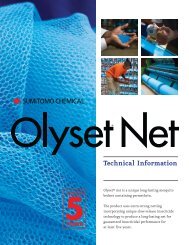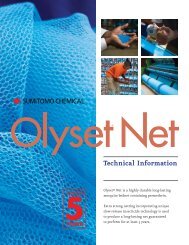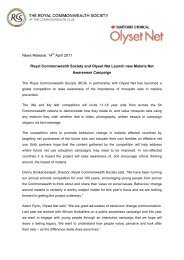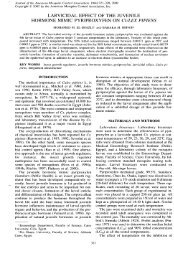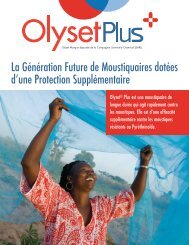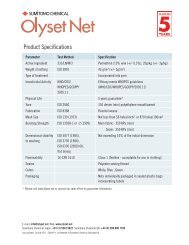SumiLarv Paper 4c - Olyset Net
SumiLarv Paper 4c - Olyset Net
SumiLarv Paper 4c - Olyset Net
Create successful ePaper yourself
Turn your PDF publications into a flip-book with our unique Google optimized e-Paper software.
61 +tu+htftctof:oduc-Itera :Bztll.str/tr
250piens pallens. We placed 15 polyethylenecontainers (40x60 cm by 15 cm deep) atan open site in the campus of ToyamaMedical and Pharmaceutical Universiry rog!9w.Cr. pipiens pallens to breed natuially(Fig. 1). After the appearance of mosquitoIarvae and pupae, 3-4 containers each werewith pyriproxyfenlgatedat dosages of 0.1,0.01, 0.001 or 0.0001 ppm (AI) or, ;rty 23,1986. Two containers for control remaineduntreated.Cesspools_B)with Cx. pipiens pallens.Tr,vo polluted waste-water cesspooi, iBx6-by 0.1 m deep and 6X7 m by 2.St m aeep;in an open site beside a pig shed where manyCx. pipiens pallens inhabited were treatedwit]r Wripoxyfen at a dosage of 0.05 ppm(AI) on July 28, 1986.C) Sewers uith Cx. pipiens pallens. Fouropen sewers (10-30m long,0.3_0.5m widebyO.05-O.2 m deep) where many Cx. pipienspallens inhabited were treated r,vith pyripro_xyfen at a dosage of 0.1 ppm (AI) t" J"ly28 or August 4, 1986. In these sewers waterwas stagnant during the day, but inflow ofhouse wastewater was observed everv morn_ing and evening.D) Ditches uith Cx. tritaeniorhvnchus.A ditch (300m long, 4.7 m wide tv O.+*deep) surrounding a farmhouse and i irrisa_tion ditches (2x5m by 0.12m aeep aina2x10 m by 0.2 m deep) in agriculturuj lurrdwhere many Cx. tritaeniorhyichus inhabitedwere treated at a dosage of 0.01 ppm (AI)on July 28 or August 4, 1986.For evaluation of the compound, the pupaland larval isolate methods were uti]ized.Pupae were collected from the test sites oneday before treatment and at intervals of l_7days after treatment till September 16. 1986(Tables 1-3, Fig. 2). Drrplicate samples of25 pupae each were ptacel in a piastic cupfilled with i00 mi deionized water, and main_tained in the laboratory at 25_27"C untilall pupae died or emersed.When pupae *"r" .,ot coliected in suffi_cient number, 3rd and 4th instar larvae w-erecoliected with field water. At site 5. B and9 of Tables 2 and 3 few pupae were collectedthroughout the survey, so that onlv the larvalisolate method tr,'as utilized. Tou.rrty_five lar_were placed in"?.^.1:ha cup *iin tOO mtof field 'uvater, from where the larvae wereJp". J. Sanit. Zool.Fig. 1 Treatment of polyethylene containersin the campus with 0.SVo pyriproxyfengranules.collected. They were fed powdered baby food(dried liver and vegetables from yukiiirushiCo., Ltd.). The observ-ation method afterpupation was the same as that in the pupalisolates. N,fortality readings were taken iuity,and dead larvae, pupae and ad.ults werecounted and removed. Adults which under_went incomplete emergence and larvae whichdied before pupation were counted as in_hibited.RpsurrslVater temperature in the test sites was23-30'C and average air temperature was21.0-29.9'C (mean 25.5"C; durine the resrperiod. It rained on August 4, 5, 6, 7,22,24.and Septembei:? '*3, 9 and rb (r;g.2). Total precipitation was iB5 mm. Inpupae from the control site and pretreatmentsamples from the test sites,in thelaboratory was observed at -oitulity 0_4.5 Vo (mean1.5% ; Tables 1-3 ) .,4) Polyethylene containers uith Cx. |tibienspallens- Adult emergence was completely inhibitedfor 40 days after treatment at a high dosage,0.1 ppm. All larvae died before pJpation inthe containers treated at 0.1 ppm fo. 25 duu,after treatment. Sufficient nlmber of punaefor evaluation first appeared 27 clavs' aiterff :T:x:,#il: 1'#::'l:,"1 J,"i;l,l;x;after then (Table 1. Fie. 2).
lool. Yol. 42 No. 3 1991I00 I+.*rn,,J"n""'---1:Table 1 Residual activity of 0.5% pyriproxy_fen granules as measured ly l"triUitioo ofadult emergence against Cx. pipiens pailensin polyethylene containers25r)od6hiterpalilv,3reerch'asAStst'2'5'lnntfetn1S:d.nFSre)tl-'],r J iil lU :i0 .tU0u1.23) (Aug.19) (Sept.1)Dai.s after Treatlnent)r/ d:Fig. 2 Residual activities of 0.5Vo pyriproxy_fen granules against Culex pipie), joilruin polyethylene containers and rain?all inToyama._ Emergence was almost inhibited for 38days and 22 days after treatment at O.Oi urra9 ool pp.*, _respectively, in spite of severaloays' rarntal.l.Inhibition was almost complete for 12 -O.OOO1 daysafter treatment at a low dosage ofppm, but the rate decreased iapidly afterrainfall during 13th_19th day after trer,*"rrr.B) Cesspools with ^Cx. pipiens pallensComplete inhibition oi -adult'emergencewas produced during 4_42 days after ireat_ment in the pupal isolates (TaLte Zl.Nearly half of inhibition for the first 2weeks in larval isolates was larval death.Nevertheless, the inhibition rate was ioou.,in the larval isolates than in pupal isolates.Some adults emerged normally l'week lftertreatment in the larval isolates. After that,the rate of normal emergence was reducedto 0-2/a, but the rate gradually increasedwithin 36-50 days after ireatment.One cesspool (Site No. 2 of Table 2) driedup for 4 days from 22nd to 25th day aftertreatment, and then the water level recovered.with rainfall. Third and 4th instar larvaeappeared again 36 days after treatment, butthe inhibition rate stayed at the 74_85%0.1Dose,\PPm/0.010.0010.00010 (control)Days aftertreatment27,40'/3Bq17-101214-i 51719-21226-B910-12l?17196-171920-313 3-38Inhibition rateof emergence(No. sariples)100 ( 1s0)1 00 (2,024)s4.s (3e )100 ( 1,758)s7 .7 (17 3)s6.1 (51 )100 ( 9)s7.3 (73)100 ( 175)91.0 (100)100 (641)ee.5 (201)100 ( 160)87.5 (B)i 1.0 (127)31.s (124)00.500.6(163)(2rB)(253)(172)the period1",::19"":*from 36 to 56 daysalter treatment.C) Sewters with Cx. pipiens pallens. Complete inhibition *u, prodrr.ed. during4-22 days after treatment in the pupal iso_lates. The inhibition rate in the iarvrl iso_lates was over B0/o within ZZ ary, uft.,treatment and then it decreased gradually(Table 2).D) Irrigation ditches with Cx. tritaenio_rhynchusThe inhibition rate in the pupal isolatesy.ur,*or..rhan 9\y'o during thl period 4 tozz Crays alter treatment. The inhibition rater^n the pupal isolates was 4g_5g% for thefirst 2 days after treatment. The same tend_ency was observed in the larval isolates. Therate rapidly dropped after rainfajl on the
,q,Jpn. J. Sanit. ZoollN^lSoN.vIrrl@O,O& -9^lYvOvIN_ic:_)m+-.^l Fn;"|jIi-.R,*:lr)(.ori)
Pn. J. Sanit. Zoo.l. Yol. 42 No. 3 1991Table 3 Residual activity ol 0.5vo .pyriproxyfen granules as measured by adult emergenceagainst Cx. tritaeniorhynchus in the 3 ditches.^RlDose( nnm )JlteI nhibrtron0.01 Pupae 0ILarvaeLarvaeLarvae(86)1. B(5s)2. I(48)) : No. sarnples. - Dried up+?.9 59.0 86.7(21) (78) (150)100\4J I2.0 95.7 97.5(50) (47) (40)100 100 100(?5) (2e) (26)Days after treatment100 100 98.2(e1) (1s7) ( los)97 .2 97 .3 73.9(36) (37) (e?)i00 97. B *(4s) (45)100(5)74.4(82)92. 9 83.3(85) (60)92.0 21. I(2s) (104)Prea.)52.0 32.0(75) (25)37. B 4{.7(111) (113)16.2(.71),.ia.v:EIIJ..1N!oz29th day after treatment, both in pupal andlarval isolates (Table 3).One irrigation ditch (Site No. 9 of Table3) dried up for 4 days, August 15-18, andthen the water level recovered with rainfall.The inhibition rate in larval isolates afterthe dry-up was still 92% 22 days after treatment,but the rate decreased rapidlv afterrainfali during 29-36 days after rreatment.DrscussroxPyriproxyfen effectively inhibited adultemergence of Cx. pipiens pallens and Cx.tritaeniorhynchus for more than 3 weeks inditches with wastewater inflow at a dosaeeof 0.1 ppm and in those with stasnant *.ort"-water of 0.01 ppm. This IGR prJduced completeinhibition of emergence -of Cx. pipienspallens for rainless 12 days in the poly_ethylene containers without mud on thebottom at a very low dosage of 0.0001 ppm,but the eflect decreased rapidly when theconcentration was diluted by rain water(Fig.2;The high effect of granular formulationwas retained in the cesspools and irrigatingditches after drying up for several div, i.,the course of the experimentsHowever, the effective component did notremain in the bottom mud foi a long periodwhen an emulsion was sprayed (Schaeferet al., 19BB). We thought that sranules ofthis IGR sank to the bottom. and the effectivecomponent rvas slowly released; thus. theefiectrve component remained in the sub_stratum for a lons time.It is already confirmed that emergenceinhibition rates were higher in pupal isJlatesthan in larval isolates (Muliigan ind Schae_fer, 1990). The same results were obtained.in the present study. Concentration was ex_pected to be higher in the.bottom than theupper water for a long time when granularformulation was applied. This IGR-is activeagainst thb larval stage, and inactive asainstpupae (Hatakoshi et al., l987 r. The agesensitivity of larvae differs in instars (Estradaand_ Mulla. 1986). Through eating bottommud and/or floating fine particles cJntainingtne actrve component, larval mideuts andMalpighian tubes are destroyed (Srlfruddinet al., 1990). Therefore, fielj-colleci"d prrp."might contact higher concentration on 'thebottom through touch and/or eating mudat their larval stage. In the larval isolateonly the field-collected water u"as used. solarvae could not contact the bottom mud atthe stage they were sensitive to the chemical.To determine the effect of IGRs in the field.pupal isolates are stable and are preferableto larval isolates. In the plots treated athigh dosage of 0.05-0.1 pp.rr, many larvaedied and- pupal populatiorx were depressed,and so the actual mortality in the test sitesai high dosages is e:
zc<strong>4c</strong>iety, Japan Environmental Sanitation Center. Weare deeply indebted to I. Tanaka, G. Shinjo, T.Okazawa, Syafruddin and the members of the JSResearch Society for their helpful suggestions.RennnrNcBsEstrada, J. G. and M. S. Mulla (19S6): Evaiua_tion of two new insect growth regulators againstmosquitoes in the laboratory. !. Am. Mosq.Control Assoc., 2: 57-60.Hatakoshi, M., H. Kawada, S. Nishida, H. Kisidaand I. Nakayama (1987): Laboratory evalua_tion of 2-{1-methyl-2-(4-phenoxyphenoxy)-etho_xy) pyridine against larvae of mosquitoes andhousefly. IFn. l. Sanit. Zool., 3g: 271_274.Ishii, T., Y. Utsumi, A. Kamada and M. Kamei(1990) : Field trials of BCp-g702 against mos_quito Iarvae in ditches. !. Sci. Uniu. Tokushima,23: 9-19 (in Japanese with English summary).Kamimura, K. (1991): Field evaluation of aninsect growth regulator, pyriproxyfen, againstthe housefly, Iulusca domestica. !pn. J. Enuiron.Entomol. Zool., Z: l-6.Kamimura, K. and Y. Maruyama (1983): Ap_pearance of highly resistant strain of Culextritaeniorhynchus to organophosphorus insecti_cides. Jpn. J. Sanit. Zool.,34: 33_37 (in Japa_nese with English summary).Kawada, H., K. Dohara and G. Shinjo (1988):Laboratory and field evaluation of an insectgrowth regulator, 4-phenoxlphenyl (RS)-2_(2_pyridyloxy) propyl ether, as a mosquito larvicide.lpn. I. Sanit. Zool., 39: 339_346.Kerdpibule, V. (1989) : A field test of 2_[1_methyl-2-(.1-phenox11:henoxy)ethoxyl pyridineagainst principal vectors of malaria in a foot_hillarea in Thailand. ]!n. I. Trop. Med.. H1,g., 17:175-183.Maruyama, Y., K. Yasutomi and Z. Ogita (1984):Electrophoretic analysis of esterase isozymes inorganophosphate-resistant mosquitoes (Culexpipiens). J. Insect. Biochern.,14: 181-188.Mian, L. S. and M. S. Mulla (1982): Biologicaland environmental dynamics of insect growthregulators (IGRs) as used against Diptera ofpublic health importance. Residue Reu., 84:27-t 1 )Mulla, NI. S., H. A. Darwazeh, B. Kennedy andD. I,I. Dawson ( 1986 ) : Evaluation of newinsect growth regulators against mosquitoes withnotes on nontarget organisms. J. Am. Mosq.Control Assoc., 2: 314-320.Jpn. J. Sanit. Zool.Nfulla, M. S., H. A. Darwazeh and E. T. Schreiber(1989): Impact of new insect growth regulatorsand their formulations on mosQuito larvaldevelopment in impoundment and floodwaterhabitats. J. Am. Mosq. Control Assoc.,5: 15_20.Mulligan III, F. S. and C. H. Schaefer (1990):Efficacy of a juvenile hormone mimic, pyriproxy_fen (S-31183), for mosquito control in dairywastewater lagoons. I. Am. Mosq. ControlAssoc., 6: B9-92.Schaefer, C. H., T. Miura, E. F. Dupras, Jr., F.Mulligan III and W. H. Wilder (1988): Efficacy)nontarget effects, and chemical persistenceof S-3 1783, a promising mosquito (Diptera:Culicidae) control agent. !. Econ. Entomol.,81: 1648-1655.Suzuki, H., T. Okazawa, N. Kere and H. Kawada(1989): Field evaluation of a new insectgrowth regulator, pyriproxyfen, against Anophelesfara,.s,ti, the main vector of malaria in theSolomon Islands. l?n. I. Sanit. Zool.,4O: 253-t3/-Syafruddin, R. Arakawa, K. Kamimura and F.Kawamoto (1990) : Histopathological effectsof an insect growth regulator, 4-phenoxyphenyl(nS)-2-(2-pyridyloxy) propyl ether (pyriproxyfen),on the larvae of Aedes aegypti. lfn. ].Sanit. Zool., 4l: 15-22.Watanabe, M., R. Arakawa and K. Kamimura( 1990 ) : Relationship between yearly changeof captured numbers and insecticide resistanceol Culex tritaeniorhynchus in Toyama prefectLne.Jpn. J. Sanit. Zool., 4l: 51-58 (in Japanesewith English summary).7 )r 4 r-tr, = )r" t 4 xr t.iJ'f 6EEffi,Fcffiilttrtfllc v t v * 2 7 t iz o)sirf.'irJr"'d'W!h#* p+ yf*Ifr,Ea4rf c t),f v * -27 t > (s-31183) 0. s%Wfrito, trWWfr\+Effi,W.tE-f rn t)t, = ti'V 4 :L/r tt.'\ti- 6gi*iJi]=dfrW.tft ? -affi"R, ffifiHlre'l- y EWLHFtkffi("f1, 0.01 -fe. ppm,trffi L/ci€zkffi-cl* o. 05 ppm, ift,tLD b6 T^i#rtt 0. 1 ppm affitrfr



